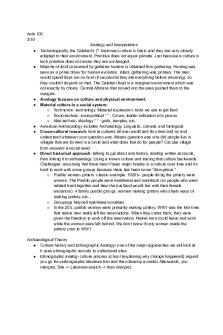Chapter 17 Additive Empathy, Interpretation, and Confrontation PDF

| Title | Chapter 17 Additive Empathy, Interpretation, and Confrontation |
|---|---|
| Author | Amanda Scheuer |
| Course | Social Work Practice I with Individuals, Families, and Groups |
| Institution | Rutgers University |
| Pages | 5 |
| File Size | 83.2 KB |
| File Type | |
| Total Downloads | 62 |
| Total Views | 164 |
Summary
Notes from chapter 17 of the Direct Social Work Practice textbook on additive empathy, interpretation, and confrontation for Professor Haranis's class....
Description
Chapter 17: Additive Empathy, Interpretation, and Confrontation ● The meaning and significance of client self-awareness ○ SWs assist clients to expand their awareness of their needs or wants, motives, emotions, beliefs, and problematic behaviors ○ Their awareness of these items’ impact on other people ○ We do not use self-awareness to refer to insight into the etiology of problems ● Additive empathy and interpretation ○ Emotional empathy: ability to be affected by a client’s emotions ○ Expressed or cognitive empathy: the translation of such feelings into words ○ Components of empathy ■ Affective sharing ■ Self-awareness ■ Mental flexibility ○ Such skills are essential in regulating compassion fatigue by enabling the SW to separate from client’s experience ○ Additive empathic responses: go beyond what clients have expressed and require some degree of inference by SWs ■ These responses interpret forces operating to produce feelings, cognitions, reactions, and behavioral patterns ○ Interpretation: additive empathic responses lead us here; the identification of patterns, goals, and wishes that clients imply but do not directly state ○ Insight through interpretation is the foremost therapeutic principle basic to psychoanalysis and closely related therapies ○ Discrepant viewpoint: sufficiently broad to encompass many change-oriented techniques identified in different theories, including reframing, relabeling, positive connotation, positive reinterpretation, additive empathy, and traditional psychoanalytic interpretations ○ Interpretations classified into two categories ■ Semantic interpretations: describe clients’ experiences according to the SW’s conceptual vocabulary ● Closely related to additive empathic responses ■ Propositional interpretations: involve SW’s notions/explanations that assert causal relationships among factors involved in clients’ problem situations ○ SWs should avoid making interpretations or additive empathic responses that are far removed from the awareness of clients ■ Moderate interpretations facilitate self-exploration and self-awareness ■ Deep interpretations are remote from clients’ experiences and appear illogical and irrelevant to clients, who therefore tend to reject them ○ Deeper feelings ■ Clients often have limited awareness of some emotions or may experience only the dominant/surface feelings ■ SWs frequently employ additive empathic responses directed at expanding clients’ awareness of feelings for several purposes:
●
○
○
○
○ ○
○
1. To identify feelings that are only implied or hinted at in clients’ verbal messages ● 2. To identify feelings that underlie surface emotions ● 3. To add intensity to feelings clients have minimized ● 4. To clarify the nature of feelings clients express only vaguely ● 5. To identify feelings manifested only nonverbally ● 6. Challenging beliefs stated as facts Underlying meanings of feelings, thoughts, and behavior ■ Additive empathy or interpretation assists clients in conceptualizing and understanding feelings, thoughts, and behavior ■ SWs assist clients in understanding what motivates them to feel, think, and behave as they do; to grasp how their behavior bears on their problems and goals, and to discern themes and patterns in their feelings, thoughts, and behavior Wants and goals ■ Important use of additive empathy is to assist clients to become aware of wants and goals they imply in their messages but don’t fully recognize ■ Messages that highlight implied wants/goals often result in formulation of explicit goals that pave the way to change-oriented actions Hidden purposes of behavior ■ SWs sometimes employ interpretation to help clients become more fully aware of basic motivations that underlie their concerns Challenging beliefs stated as facts ■ Sometimes clients have strongly held beliefs they consider to be facts Unrealized strengths and potentialities ■ Interpretation and additive empathy expands clients’ awareness of their strengths and undeveloped potentialities ■ Clients’ strengths demonstrated in a variety of ways and SWs need to sensitize themselves to these often subtle manifestations ● Consciously cultivate a positive perceptual set ■ Drawing clients’ awareness to strengths tends to enhance self-esteem and to foster courage to undertake tasks that involve risking new behaviors Guidelines for employing interpretation and additive empathy ■ 1. Use additive empathy sparingly until a sound working relationship has evolved ■ 2. Employ these responses only when clients are engaged in selfexploration or have shown that they are ready to do so ■ 3. Pitch these responses to the edge of clients’ self-awareness and avoid attempting to foster awareness that is remote from clients’ current awareness or experiences ■ 4. Avoid making several additive empathic responses in succession ■ 5. Phrase interpretive responses in tentative terms ■ 6. To determine the accuracy of an interpretive response, carefully note
■
■
●
clients’ reactions after offering the interpretation 7. If the client responds negatively to an interpretative response, acknowledge your probable error, respond empathically to the client’s reaction, and continue your discussion of the topic under consideration 8. When providing an interpretation to a client who is culturally different from the SW, recognize that the client may not readily understand the message the way it was intended
Confrontation ○ Tool to enhance clients’ self-awareness and to promote change ○ Involves facing clients with some aspect of their thoughts, feelings, or behavior that is contributing to or maintaining their difficulties ○ Stages of change model
stage
Characteristic behavior
Social worker’s task
precontemplation
Client does not believe that he/she has a problem; is considered unmotivated by others
Raise awareness of concerns held by others: “What does your partner think about the effect of your drinking on your home life?”
contemplation
Becomes aware of the existence of the problem but is not moved to action; appears ambivalent--shows awareness, then discounts it
Attempt to tip decisional balance by exploring reasons to change: “As you add it up, what do you think the benefits are in relation to the costs?”
preparation
Recognizes problem; asks what can be done to change; appears motivated
Strengthen confidence in change as a possibility; help client plan appropriate course of action
action
Implements plan of action
Develop plan to implement action; plan details to make it possible (transportation, child care, etc.)
maintenance
Sustain change through consistent application of strategies
Identify strategies to prevent lapses and relapse; “What have been the triggers to expose you to a dangerous situation?”
relapse
Slips into problematic behavior and may return to precontemplation stage
Attempt to return to contemplation without being stuck or demoralized; reinforce achievement; treat with respect: “This is a difficult time. You have been
at this point before and you overcame it. What do you think about whether you want to overcome it again?” ○
○
○
Self-confrontation ■ SWs would more appropriately consider confrontation to exist along a continuum that ranges from fostering self-confrontation to assertive confrontation ■ Clients can often be engaged quickly in self-confrontation by SWs’ asking them questions that cause them to reflect on the relationship between their behaviors and their own values Assertive confrontation ■ When danger is imminent, SW may not be able to rely on tactful selfconfrontation facilitated by inductive questioning ■ They may have to engage in more assertive confrontation ● Connection between troubling thoughts, plans, values, and beliefs is stated in declarative form, connecting them explicitly ● More high-risk technique because clients may interpret as criticisms, put-downs, or rejections ■ Effective assertive confrontations embody four elements ● 1. Expression of concern ● 2. A description of the client’s purported goal, belief, or commitment ● 3. The behavior (or absence of behavior) that is inconsistent or discrepant with the goal, belief, or commitment ● 4. The probably negative outcomes of the discrepant behavior ■ Format: ● I am concerned because you (want/believe/are striving to) … (desired outcome) … but your … (discrepant action, behavior or inaction) … is likely to produce … (probably negative consequence) Guidelines for employing confrontation ■ 1. When a violation of the law or imminent danger to self or others is involved, a confrontation must occur no matter how early in the working relationship ■ 2. Whenever possible, avoid confrontation until an effective working relationship has been established ■ 3. Use confrontation sparingly ■ 4. Deliver confrontations in an atmosphere of warmth, caring, and concern ■ 5. Whenever possible, encourage self-confrontation ■ 6. Avoid using confrontation when clients are experiencing extreme emotional strain
■ ■
○
7. Follow confrontation with empathic responsiveness 8. Expect that clients will respond to confrontation with a certain degree of anxiety ■ 9. Do not expect immediate change after confrontations ● Working through: change process that involves repeatedly reviewing the same conflicts and the client’s typical reactions to them, gradually broadening the perspective to encompass increasingly more situations to which the changes are applicable ● Pressing for immediate change can inflict psychological damage on clients Indications for assertive confrontation ■ Confrontation is appropriate in three circumstances ● 1. When violations of the law or imminent threats to the welfare and safety of self or others are involved ● 2. When discrepancies, inconsistencies, and dysfunctional behaviors (overt/covert) block progress or create difficulties ● 3. When efforts at self-confrontation and inductive questioning have been ineffective in fostering clients’ awareness of these behaviors or attempts to make corresponding changes ■ Cognitive/perceptual discrepancies ● Confrontation may assist clients with behavioral/perceptual difficulties in modifying their problematic behaviors or misconceptions about the self ■ Affective discrepancies ● Emotional discrepancies are linked to cognitive/perceptual processes ● SWs commonly encounter denying or minimizing actual feelings, being out of touch with painful emotions, expressing feelings that are contrary to purported feelings, etc. ■ Behavioral discrepancies ● Irresponsible behavior tends to spawn serious interpersonal difficulties for clients as well as problems with broader society ● Neglect of children, weak efforts to secure/maintain employment, undependability in fulfilling assignments, failure to maintain property--result in severe financial, legal, interpersonal entanglements and may culminate in loss of employment, estrangement from others, and loss of property, child custody, selfrespect and even personal freedom ● Three common categories of discrepancies or dysfunctional behavior that warrant confrontation are manipulative behavior, dysfunctional communication, and resistance to change...
Similar Free PDFs

Basiclistening and empathy 2
- 15 Pages

Les verbes de confrontation
- 1 Pages

17 - Chapter 17
- 23 Pages

2. Empathic Confrontation
- 2 Pages

Empathy Map
- 1 Pages

Chapter 17 and 18 Study
- 3 Pages

Chapter 17 - Stress and Health
- 3 Pages

Chapter 17
- 9 Pages

Chapter 17
- 15 Pages

Customer empathy map
- 4 Pages
Popular Institutions
- Tinajero National High School - Annex
- Politeknik Caltex Riau
- Yokohama City University
- SGT University
- University of Al-Qadisiyah
- Divine Word College of Vigan
- Techniek College Rotterdam
- Universidade de Santiago
- Universiti Teknologi MARA Cawangan Johor Kampus Pasir Gudang
- Poltekkes Kemenkes Yogyakarta
- Baguio City National High School
- Colegio san marcos
- preparatoria uno
- Centro de Bachillerato Tecnológico Industrial y de Servicios No. 107
- Dalian Maritime University
- Quang Trung Secondary School
- Colegio Tecnológico en Informática
- Corporación Regional de Educación Superior
- Grupo CEDVA
- Dar Al Uloom University
- Centro de Estudios Preuniversitarios de la Universidad Nacional de Ingeniería
- 上智大学
- Aakash International School, Nuna Majara
- San Felipe Neri Catholic School
- Kang Chiao International School - New Taipei City
- Misamis Occidental National High School
- Institución Educativa Escuela Normal Juan Ladrilleros
- Kolehiyo ng Pantukan
- Batanes State College
- Instituto Continental
- Sekolah Menengah Kejuruan Kesehatan Kaltara (Tarakan)
- Colegio de La Inmaculada Concepcion - Cebu





